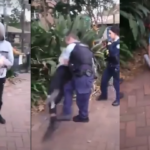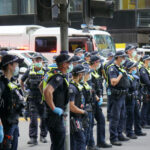NSW Police Under Fire for Manhandling Woman with Baby

New South Wales Police have again come under scrutiny for heavy handed policing after manhandling a woman with a baby at an event in Sydney where Prime minister Anthony Albanese was speaking.
According to bystanders, the pro-Palestine protester had a sign that said “Shame Albo” and a picture of a watermelon – a symbol of Palestinian identity and resistance.
The woman started chanting when the Prime Minister began to speak, but quickly quietened down, when he acknowledged her from the stage and requested that the event remain peaceful.
Police manhandle small, well-behaved female protester
She nodded, and stood silently with her sign, but it only took moments for police to rush to the woman, attempt to take her sign and move her on, until she sat on the ground.
The incident has many questioning why officers simply couldn’t just speak with the protester, instead of having to forcefully grab her.
The two officers were armed and much bigger than the woman who very obviously had her hands full – one hand was holding a sign, one arm was holding a baby balanced on her hip.
Several bystanders filmed the event, and MP Jenny Leong posted a video of the incident online, captioning it: “This is NOT normal. This is NOT ok.”
But most residents across Australia undoubtedly say that it is normal, or at least it is fast becoming so, particularly here in New South Wales.
‘Normal policing’
Much has been reported about police behaviour and the use of excessive and unnecessary force over the past several years, but the recent incident involving the protester is a simple, yet very clear example of how police – who wear protective gear and are armed – are often the ones who set a confrontational tone in their interactions with members of the community, before arrests are even made.
When people feel they are under threat, they will do one of three things – try to flee, fight back, or freeze. Lawmakers have long acknowledged these instinctive behavioural responses and recently changed sexual assault and sexual consent laws to better reflect this.
If officers approached calmly, and made no attempt at manhandling when it’s not necessary, then perhaps there would be less altercations between police and the general public across the board. This may even result in less arrests.
Increasing complaints about ‘use of excessive / unnecessary force’
The most recent statistics available show that in the year 2021-2022, the police watchdog, Law Enforcement Conduct Commission (LECC) received more than 5,000 complaints about New South Wales police. Perhaps not surprisingly the highest number of complaints related to excessive use of force and police brutality.
Under the Law and Enforcement (Powers and Responsibilities) Act 2002, (the LEPRA) Police can use force as is “reasonably necessary” to make an arrest (section 231) or to exercise a lawful function (section 230).
The definition of “excessive force” is broad and force should only be used as a last resort. In situations where excessive force has been used, which results in an injury or a complaint, then matters are investigated to ensure that force was justified and that the officer acted within their legal authority.
However, since the LEPRA was enacted in 2002, complaints about police have risen sharply, and the nature of these complaints is increasingly serious as documented by CCTV footage, police worn body cameras, taser cameras and bystander video.
Lack of police accountability
However, one serious problem in terms of police accountability in New South Wales is that the police force does have a tendency to want to justify the use of force, irrespective of the circumstances, and also sweep incidents under the carpet.
Another considerable issue is the lack of reporting, translating into publicly available, up-to-date statistics outlining the number of complaints, the nature of complaints and how these are resolved.
That said, in the eyes of many, cultural change within the police force is long overdue – communities have had enough of macho, thuggish behaviour, and an over-reliance on the use of force and weaponry. However the message seems to be falling on deaf ears within the top brass of the New South Wales Police Force, and also with the New South Wales Minister for Police.
Two very serious cases are currently before the courts – the New South Wales police officer who tasered a 95-year old grandmother in a nursing home, which resulted in her death, has now been charged with manslaughter. The family is taking civil action against NSWPF.
In October, the Law Enforcement Conduct Commission (LECC) recommended charges against a New South Wales police officer who tackled a slightly built 17-year-old First Nations boy who attempted to make a run for it while waiting for treatment in hospital. The officer tackled the boy, and while he was defenceless on the ground punched him in the face three times. Then, after hancuffing the boy, dragged him 5 metres along the floor back to his seat.
These are not isolated incidents, but they both serve as a stark reminder that the days of more civilised types of community policing are gone.
Common assault
Behaviour such as the manhandling in the video above, if it occurred between two members of the public, could actually amount to common assault under the law, which is defined under section 61 of the Crimes Act 1900.
To establish the offence, the following elements must be proven beyond a reasonable doubt:
- That a person caused another person to fear immediate and unlawful violence, or made physical contact with another person, and the other person did not consent, and
- That your actions were intentional or reckless.
There does not need to be an intention or power to use violence; it is enough for the other person to believe on reasonable grounds that there is an imminent danger of it.
Examples of common assault include:
- Hitting another person without causing any, or any significant, injuries,
- Threatening immediate violence in such a way the other person believes the threat will be carried through; for example, saying ‘I’m gonna punch you in the face’ while gesturing aggressively, moving towards the other person and/or displaying threatening behaviour.
- Striking at a person with a fist or object, whether or not contact is made,
- Throwing an object towards a person, whether or not contact is made,
- Spitting at another person, whether or not contact is made.
The legal defences to common assault include:
- Self-Defence,
- Duress,
- Necessity, and
- Lawful correction of a minor.
The maximum penalty for common assault is 2 years in prison and/or a fine of $5,500.







